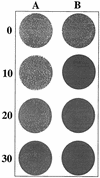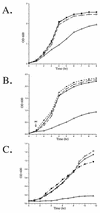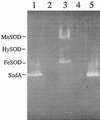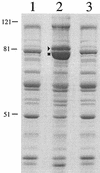Inactivation of the Moraxella catarrhalis superoxide dismutase SodA induces constitutive expression of iron-repressible outer membrane proteins
- PMID: 11895952
- PMCID: PMC127887
- DOI: 10.1128/IAI.70.4.1889-1895.2002
Inactivation of the Moraxella catarrhalis superoxide dismutase SodA induces constitutive expression of iron-repressible outer membrane proteins
Abstract
Many pathogens produce one or more superoxide dismutases (SODs), enzymes involved in the detoxification of endogenous and exogenous reactive oxygen species that are encountered during the infection process. One detectable cytoplasmic SOD was identified in the human mucosal pathogen Moraxella catarrhalis, and the gene responsible for the SOD activity, sodA, was isolated from a recent pediatric clinical isolate (strain 7169). Sequence analysis of the cloned M. catarrhalis 7169 DNA fragment revealed an open reading frame of 618 bp encoding a polypeptide of 205 amino acids with 48 to 67% identity to known bacterial manganese-cofactored SODs. An isogenic M. catarrhalis sodA mutant was constructed in strain 7169 by allelic exchange. In contrast to the wild-type 7169, the 7169::sodK20 mutant was severely attenuated for aerobic growth, even in rich medium containing supplemental amino acids, and exhibited extreme sensitivity to the redox-active agent methyl viologen. The ability of recombinant SodA to rescue the aerobic growth defects of E. coli QC774, a sodA sodB-deficient mutant, demonstrated the functional expression of SOD activity by cloned M. catarrhalis sodA. Indirect SOD detection assays were used to visualize both native and recombinant SodA activity in bacterial lysates. This study demonstrates that M. catarrhalis SodA plays a critical role in the detoxification of endogenous, metabolically produced oxygen radicals. In addition, the outer membrane protein (OMP) profile of 7169::sodK20 was consistent with iron starvation in spite of growth under iron-replete conditions. This novel observation indicates that M. catarrhalis strains lacking SodA constitutively express immunogenic OMPs previously described as iron repressible, and this potentially attenuated mutant strain may be an attractive vaccine candidate.
Figures






Similar articles
-
Pseudomonas aeruginosa sodA and sodB mutants defective in manganese- and iron-cofactored superoxide dismutase activity demonstrate the importance of the iron-cofactored form in aerobic metabolism.J Bacteriol. 1995 Nov;177(22):6330-7. doi: 10.1128/jb.177.22.6330-6337.1995. J Bacteriol. 1995. PMID: 7592406 Free PMC article.
-
Cloning and characterization of the Pseudomonas aeruginosa sodA and sodB genes encoding manganese- and iron-cofactored superoxide dismutase: demonstration of increased manganese superoxide dismutase activity in alginate-producing bacteria.J Bacteriol. 1993 Dec;175(23):7658-65. doi: 10.1128/jb.175.23.7658-7665.1993. J Bacteriol. 1993. PMID: 8244935 Free PMC article.
-
Contribution of the Mn-cofactored superoxide dismutase (SodA) to the virulence of Yersinia enterocolitica serotype O8.Infect Immun. 1997 Nov;65(11):4705-10. doi: 10.1128/iai.65.11.4705-4710.1997. Infect Immun. 1997. PMID: 9353054 Free PMC article.
-
Roles of manganese and iron in the regulation of the biosynthesis of manganese-superoxide dismutase in Escherichia coli.FEMS Microbiol Rev. 1994 Aug;14(4):315-23. doi: 10.1111/j.1574-6976.1994.tb00105.x. FEMS Microbiol Rev. 1994. PMID: 7917419 Review.
-
Regulation of sod genes in Escherichia coli: relevance to superoxide dismutase function.Mol Microbiol. 1991 Nov;5(11):2599-610. doi: 10.1111/j.1365-2958.1991.tb01968.x. Mol Microbiol. 1991. PMID: 1779751 Review.
Cited by
-
Identification of Campylobacter jejuni genes involved in its interaction with epithelial cells.Infect Immun. 2010 Aug;78(8):3540-53. doi: 10.1128/IAI.00109-10. Epub 2010 Jun 1. Infect Immun. 2010. PMID: 20515930 Free PMC article.
-
Identification of a novel two-partner secretion locus in Moraxella catarrhalis.Infect Immun. 2007 Jun;75(6):2929-36. doi: 10.1128/IAI.00396-07. Epub 2007 Apr 9. Infect Immun. 2007. PMID: 17420235 Free PMC article.
-
Proteome of a Moraxella catarrhalis Strain under Iron-Restricted Conditions.Microbiol Resour Announc. 2020 Mar 19;9(12):e00064-20. doi: 10.1128/MRA.00064-20. Microbiol Resour Announc. 2020. PMID: 32193234 Free PMC article.
-
Characterization of a trifunctional glucosyltransferase essential for Moraxella catarrhalis lipooligosaccharide assembly.Glycobiology. 2013 Aug;23(8):1013-21. doi: 10.1093/glycob/cwt042. Epub 2013 May 29. Glycobiology. 2013. PMID: 23720461 Free PMC article.
-
Expression of type IV pili by Moraxella catarrhalis is essential for natural competence and is affected by iron limitation.Infect Immun. 2004 Nov;72(11):6262-70. doi: 10.1128/IAI.72.11.6262-6270.2004. Infect Immun. 2004. PMID: 15501752 Free PMC article.
References
-
- Battistoni, A., F. Pacello, S. Folcarelli, M. Ajello, G. Donnarumma, R. Greco, M. G. Ammendolia, D. Touati, G. Rotilio, and P. Valenti. 2000. Increased expression of periplasmic Cu,Zn superoxide dismutase enhances survival of Escherichia coli invasive strains within nonphagocytic cells. Infect. Immun. 68:30-37. - PMC - PubMed
-
- Beauchamp, C., and I. Fridovich. 1971. Superoxide dismutase: improved assays and an assay applicable to acrylamide gels. Anal. Biochem. 44:276-287. - PubMed
-
- Beck, B. L., L. B. Tabatabai, and J. E. Mayfield. 1990. A protein isolated from Brucella abortus is a Cu-Zn superoxide dismutase. Biochemistry 29:372-376. - PubMed
Publication types
MeSH terms
Substances
Grants and funding
LinkOut - more resources
Full Text Sources
Medical

